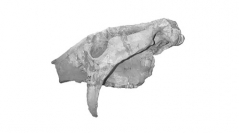

 Comptes Rendus Palevol
16 (3) - Pages 303-311
Comptes Rendus Palevol
16 (3) - Pages 303-311Within the Late Neogene Glyptodontidae of the Pampean region of Argentina, “Urotherium antiquum” was described on the basis of some associated osteoderms of the dorsal carapace, which in addition include a partial skull and left hemimandible. The diagnostic characters are located on the exposed surface of the osteoderms of the dorsal carapace which somewhat resembles those of the Pleistocene genus Neuryurus. Although the relationship of “U. antiquum” to the remaining Glyptodontidae has never been clarified, some cladistic analyses suggest a close phylogenetic affinity with the clade composed of Plohophorus + (Glyptodon + Doedicurus). A careful comparison of “U. antiquum” to well-characterized taxa with similar stratigraphic and geographic provenance reveals that no significant skull differences are observed from Plohophorus figuratus Ameghino. It seems likely that the alleged ornamentation pattern that characterizes this species was produced by a taphonomic alteration of the exposed surface of the osteoderms, a process broadly distributed in glyptodonts having a “rosette” ornamentation pattern. Finally, some characters present in the osteoderms of the type specimen of “U. antiquum” suggest that it may be a juvenile specimen. In summary, “U. antiquum” should be considered a junior synonym of P. figuratus.
Urotherium antiquum, Plohophorus, Monte Hermoso Formation, Osteoderms, Neogene, Argentina